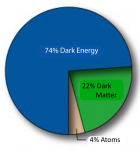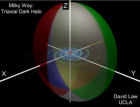Abstract
Review Article
Fifth “dark” force completely change our understanding of the universe
Robert Skopec*
Published: 29 July, 2019 | Volume 3 - Issue 1 | Pages: 035-041
For something that’s literally as old as the universe, dark matter doesn’t get much attention outside scientific circles. Maybe that’s because, other than a short-lived SyFy series and a late-period Randy Newman album, this nebulous star stuff has had a tough time breaking the pop-culture barrier. But the truth is that today, dark matter has never mattered more. Our own Milky Way is embedded in a massive cloud of it, we’re looking for its interactions deep inside the earth, and there are whole galaxies without it. So what is dark matter, anyway? Why can’t scientists get enough of the stuff, even though they can’t actually find it? What deep, dark secrets does it hold? And could it ultimately shape the future of life as we know it?
Read Full Article HTML DOI: 10.29328/journal.acst.1001006 Cite this Article Read Full Article PDF
Keywords:
Dark matter; Dark energy; Radioactive decay; Neutrinoless double beta decay; Majorana fermion; Superflares; Coronal mass ejection; NASA Kepler space telescope; European Space Agency’s Gaia spacecraft; Gravitational lensing; Gamma radiation-detecting space telescopes
References
- Bartels M. Newsweek. 2018.
- Darimont CT, Fox CH, Bryan HM, Reimchen TE. The unique ecology of human predators. Science. 2015; 349: 858-860. PubMed: https://www.ncbi.nlm.nih.gov/pubmed/26293961
- Dolev Sch. The quantum computing appocalypse is imminent. Tech Chrunch. 2018.
- Gibbons D. General proof and method of sustained state management in autonomous systems. Personal communications. 2018; 5.
- Gold JI, Shadlen MN. The Neural Basis of Decision Making. Annu Rev Neurosci. 2007; 30: 535-574. PubMed: https://www.ncbi.nlm.nih.gov/pubmed/17600525
- Howell E. Our Aging Sun Is Still Capable of Unleashing 'Superflares.' Should We Worry? Science & Astronomy. 2019.
- Hsu M, Kraibich I, Zhao C, Camerer CF. Neural Response to Reward Anticipation Under Risk Is Nonlinear in Probabilities. J Neurosci. 2009; 29: 2231-2237. PubMed: https://www.ncbi.nlm.nih.gov/pubmed/19228976
- Kourtidis A, Ngok SP, Anastasiadis PZ. Distinct E-cadherin-based complexes regulate cell behavior through miRNA processing or Src and p120 catenin activity. Nat Cell Biol. 2015; 17: 1145-1157. PubMed: https://www.ncbi.nlm.nih.gov/pubmed/26302406
- Lin J, Marcolli M, Ooguri H, Stoica B. Tomography from Entanglement. 2014.
- Lincoln, 2018.
- Lindsey J. So...What Is Dark Matter Anyway? Popular Mechanics, May 31, 2019 Mayo Clinic. (2015) Discovery of new code makes reprogramming of cancer possible.
- Masterson A. Multiverse theory cops a blow after dark energy findings. Cosmos. 2018.
- Medrano K. Physics: Scientists Rewrite Quantum Theory to Do the Impossible Track Secret Particles. 2017.
- Paulus MP, Frank LR. Anterior cingulated activity modulates nonlinear decision weight function of uncertain prospects. Neuroimage. 2006; 30: 668-677. PubMed: https://www.ncbi.nlm.nih.gov/pubmed/16321546
- Prigogine I. The End of Certainty. Time, Chaos, and the New Laws of Nature. First Free Press Edition. 1997; 161-162.
- Ramachandran VS, Hubbard EM. Psychological Investigation into the Neural Basis of Synesthesia. Proceedings of the Royal Society of London. 2001; 268: 979-983.
- Rechtsman M. Penn State Univesity. Nature. 2018.
- Seitz D. 2018: https://www.yahoo.com/news/majorana-fermion-going-change-world-185818775.html
- Siegl E. https://www.forbes.com/sites/startswithabang/2018/01/10/new-dark-matter-physics-could-solve-the-expanding-univrse-controversy/#5
- Wall M. Science & Astronomy 2016.
- University of California – Berkeley. “Recording a thought’s fleeting trip through the brain: Electrodes on brain surface provide best view yet of prefrontal cortex coordinating response to stimuli.” 2018.
- Skopec R. I. An Explanation of Biblic Radiation: Plasma. Journal of Psychiatry and Cognitive Behavior. 2017.
- Skopec R. II. Artificial hurricanes and other new Weapons of Mass Destruction. International Journal of Scientific Research and Management. 2018; 7751-7764.
- Skopec R. III. Intelligent Evolution, Complexity and Self-Organization. NeuroQuantology. 2015; 13: 299-303.
- Skopec R. IV. Translational Biomedicine and Dichotomous Correlations of Masking. Translational Biomedicine. 2016; 1: 47.
Figures:

Figure 1

Figure 2

Figure 3

Figure 4

Figure 5
Similar Articles
-
Fifth “dark” force completely change our understanding of the universeRobert Skopec*. Fifth “dark” force completely change our understanding of the universe. . 2019 doi: 10.29328/journal.acst.1001006; 3: 035-041
Recently Viewed
-
A Update on Brachytherapy for Cervical Cancer: A ReviewArjun Moorthy,Ayan Issac,Ngoc-Anh Le,Kavin Mutyala*,Bhuvi Mamtani,Shyamal Patel,Lyndsay Willmott. A Update on Brachytherapy for Cervical Cancer: A Review. Clin J Obstet Gynecol. 2025: doi: 10.29328/journal.cjog.1001195; 8: 085-091
-
Superior Gluteal Artery Pseudoaneurysm following a Periacetabular OsteotomyTess Szekelyi, Xavier Lannes, Mouas Jammal, Salah Dine Qanadli, Michael Wettstein*. Superior Gluteal Artery Pseudoaneurysm following a Periacetabular Osteotomy. Arch Clin Exp Orthop. 2024: doi: 10.29328/journal.aceo.1001018; 8: 001-004
-
Breast Imaging Services Utilization Trends Across Private and Government-Insured Patients in a National Radiology PracticeAndrew K Hillman*,Phil Ramis,Patrick Nielsen,Sophia N Swanston,Dana Bonaminio,Eric M Rohren. Breast Imaging Services Utilization Trends Across Private and Government-Insured Patients in a National Radiology Practice. J Clin Med Exp Images. 2025: doi: 10.29328/journal.jcmei.1001037; 9: 020-027
-
Effect of Obesity on the Patients Undergoing to General Anesthesia: A Prospective StudyAhmed Ali Ebshena*,Zubaeda M Alsayeh. Effect of Obesity on the Patients Undergoing to General Anesthesia: A Prospective Study. Int J Clin Anesth Res. 2025: doi: 10.29328/journal.ijcar.1001032; 9: 030-034
-
Transnasal Humidified Rapid-Insufflation Ventilatory Exchange (THRIVE) in High-Risk Endoscopic Procedures: A Non-Intubation ApproachNaba Madoo*,Vaibhavi Baxi. Transnasal Humidified Rapid-Insufflation Ventilatory Exchange (THRIVE) in High-Risk Endoscopic Procedures: A Non-Intubation Approach. Int J Clin Anesth Res. 2025: doi: 10.29328/journal.ijcar.1001033; 9: 035-036
Most Viewed
-
Feasibility study of magnetic sensing for detecting single-neuron action potentialsDenis Tonini,Kai Wu,Renata Saha,Jian-Ping Wang*. Feasibility study of magnetic sensing for detecting single-neuron action potentials. Ann Biomed Sci Eng. 2022 doi: 10.29328/journal.abse.1001018; 6: 019-029
-
Evaluation of In vitro and Ex vivo Models for Studying the Effectiveness of Vaginal Drug Systems in Controlling Microbe Infections: A Systematic ReviewMohammad Hossein Karami*, Majid Abdouss*, Mandana Karami. Evaluation of In vitro and Ex vivo Models for Studying the Effectiveness of Vaginal Drug Systems in Controlling Microbe Infections: A Systematic Review. Clin J Obstet Gynecol. 2023 doi: 10.29328/journal.cjog.1001151; 6: 201-215
-
Causal Link between Human Blood Metabolites and Asthma: An Investigation Using Mendelian RandomizationYong-Qing Zhu, Xiao-Yan Meng, Jing-Hua Yang*. Causal Link between Human Blood Metabolites and Asthma: An Investigation Using Mendelian Randomization. Arch Asthma Allergy Immunol. 2023 doi: 10.29328/journal.aaai.1001032; 7: 012-022
-
An algorithm to safely manage oral food challenge in an office-based setting for children with multiple food allergiesNathalie Cottel,Aïcha Dieme,Véronique Orcel,Yannick Chantran,Mélisande Bourgoin-Heck,Jocelyne Just. An algorithm to safely manage oral food challenge in an office-based setting for children with multiple food allergies. Arch Asthma Allergy Immunol. 2021 doi: 10.29328/journal.aaai.1001027; 5: 030-037
-
Impact of Latex Sensitization on Asthma and Rhinitis Progression: A Study at Abidjan-Cocody University Hospital - Côte d’Ivoire (Progression of Asthma and Rhinitis related to Latex Sensitization)Dasse Sery Romuald*, KL Siransy, N Koffi, RO Yeboah, EK Nguessan, HA Adou, VP Goran-Kouacou, AU Assi, JY Seri, S Moussa, D Oura, CL Memel, H Koya, E Atoukoula. Impact of Latex Sensitization on Asthma and Rhinitis Progression: A Study at Abidjan-Cocody University Hospital - Côte d’Ivoire (Progression of Asthma and Rhinitis related to Latex Sensitization). Arch Asthma Allergy Immunol. 2024 doi: 10.29328/journal.aaai.1001035; 8: 007-012

If you are already a member of our network and need to keep track of any developments regarding a question you have already submitted, click "take me to my Query."



















































































































































